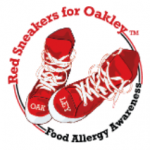The call to action is clear for people with food allergies. Always keep your epinephrine auto-injectors with you. Always carry two.
But why?
In this post, Red Sneakers for Oakley explains.
Beyond the “Why TWO?”
- Is it common to need more than one dose?
- How do you know if you should give someone a 2nd dose of epinephrine for an anaphylactic reaction?
- How soon should you give the 2nd dose after giving the 1st one?
Here’s what you need to know
According to NIAID Guidelines (1):
- As many as 10 to 20% of people — more than 1 in 10 — who are administered epinephrine will need more than 1 dose.
- You should give a 2nd dose of epinephrine if a patient has ongoing symptoms or they are getting worse after initial dosing.
- Repeated dosing may be required after 5 to 15 minutes.
In a 2008 study (2) by the Division of Pediatric Allergy and Immunology and Jaffe Institute for Food Allergy, Mount Sinai School of Medicine, 19% of food-induced anaphylactic reactions were treated with multiple doses of epinephrine — 13% receiving two doses, 6% receiving three doses.
In the study (conducted via anonymous questionnaires, N=413), administration of the second and third doses of epinephrine occurred usually within 30 minutes from the administration of the previous dose, although this finding was subject to significant recall bias due to the study design.
In the majority of the reactions, multiple doses of epinephrine were due to lack of response to the first dose. Additional reasons for requiring a second dose of epinephrine include inadequate dose of epinephrine per kilogram of body weight, an expired device, or improper use of the device, though the survey, as designed, could not capture data supporting this.
A subsequent study (3) in 2018 by the Division of Allergy and Immunology, Department of Pediatrics, Icahn School of Medicine at Mount Sinai corroborated that food-related anaphylactic reactions may require treatment with more than 1 dose of epinephrine.
What does this mean {practically} for people managing food allergies?
- Make sure you always have 2 auto-injectors within reach at all times.
- When you use your epinephrine auto-injector, note the time of the injection.
- If anaphylaxis symptoms do not improve or worsen after the 1st dose, give a 2nd dose within a 5 to 15 minute window.
- Do not wait for the ambulance to arrive.
- Always, always consult with your allergist if you have specific questions about administering a 2nd dose of epinephrine or your particular condition.
Red Sneakers for Oakley seeks to equip you with the best possible data from published sources that can help keep you safe. Thank you @redsneakersforoakley for summarizing this important information and permitting us to share it with the Allergy Force community.
PUT ON YOUR RED SNEAKERS
in support of food allergy awareness
in memory of Oakley Debbs

In November 2016, the Debbs Family tragically lost their 11-year-old son, Oakley, to a fatal anaphylactic reaction resulting from a mild nut allergy. Shortly after Oakley’s death, the family decided to publicly share Oakley’s story to help raise awareness about the dangers of food allergies. They saw a need for awareness and founded the non-profit organization Red Sneakers for Oakley in memory of their son. Oakley wore red sneakers in the multiple sports he played so it was only natural that the family looked to Oakley’s favorite shoes as a powerful symbol to represent the severity of food allergies. Please support @redsneakersforoakley. |
|
… |
|
Credits: Image and content courtesy of Red Sneakers for Oakley
Sources
1. (2010) NIAID Report
Report of the NIAID-Sponsored Expert Panel: Guidelines for the Diagnosis & Management of Food Allergy in the US || URL: www.jacionline.org/article/S0091-6749(10)01566-6/fulltext
2. (2008) Study from the Division of Pediatric Allergy and Immunology and Jaffe Institute for Food Allergy, Mount Sinai School of Medicine
Use of multiple doses of epinephrine in food-induced anaphylaxis in children || URL: www.jacionline.org/article/S0091-6749(08)00775-6/fulltext
3. (2018) Study from the Division of Allergy and Immunology, Department of Pediatrics, Icahn School of Medicine at Mount Sinai
Risk factors for multiple epinephrine doses in food-triggered anaphylaxis in children || URL: www.annallergy.org/article/S1081-1206(18)30507-6/fulltext


